Apple previewed OS X 10.9 Mavericks at the June 2013 Worldwide Developer Conference (WWDC), and it appears to be a big step forward for OS X – perhaps the biggest since Apple made the transition from the “classic” Mac OS 9 to OS X 10.0 way back in March 2001.
OS X Mavericks had been expected to ship at the same time as the 2013 Mac Pro, but it arrived at the Mac App Store on 2013.10.22 with the Mac Pro delayed until December. Perhaps the biggest surprise is that Mavericks is free, and since it will run on any Mac that supports OS X 10.8 Mountain Lion, it has become a runaway success.
Oldest Supported Macs
- Mid 2007 15″ MacBook Pro
- Mid 2007 17″ MacBook Pro
- Mid 2007 iMacs
- Early 2008 Mac Pro
- Late 2008 Aluminum Unibody MacBook
- Late 2008 MacBook Air
- Early 2009 MacBook White
- Early 2009 Mac mini
- Early 2009 Xserve
- Mid 2009 13″ MacBook Pro
Warning: Mavericks was updated to version 10.9.2 in February 2014 to correct for the “goto fail” bug . See Apple and the ‘goto fail’ Bug for information on updating Mavericks.
Features
Improved Performance
Those who remember the move from the Classic Mac OS to Mac OS X remember how excruciatingly slow OS X seemed compared to the traditional Mac OS. Apple improved things over the years, but even today it can take a while for a Finder window to list hundreds of files within a folder.
OS X switched the Mac from “cooperative” (or not so cooperative, since any app could take over) multitasking to pre-emptive multitasking, and the Time Coalescing feature in Mavericks will take a huge step forward, optimizing CPU usage and reducing it by up to 72%, according to Apple, which will let MacBooks run longer and desktop Macs run cooler.
App Nap will put programs to sleep when they are not visible, although there will certainly be some apps able to run while out of sight.
OS X 10.9 will automatically compress the memory used by inactive apps, providing more system memory to active ones.
Apple is also adopting OpenCL 1.2 and OpenGL 4.1, which should improve display speed.
Multiple Screen Support

The menu bar and Dock can be accessed on secondary displays, and Apple TV can be used as an external display. Mission Control has been updated to switch between workspaces independently between multiple displays.
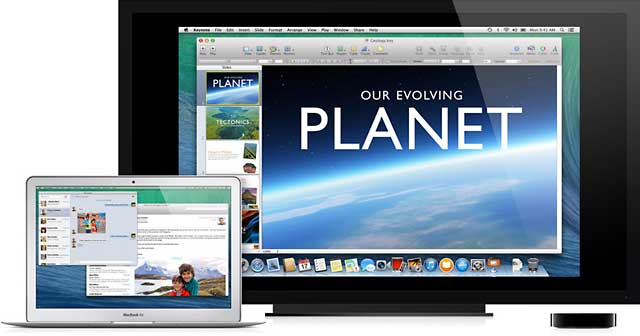
OS X Mavericks supports AirPlay to display using Apple TV
Tabbed Finder
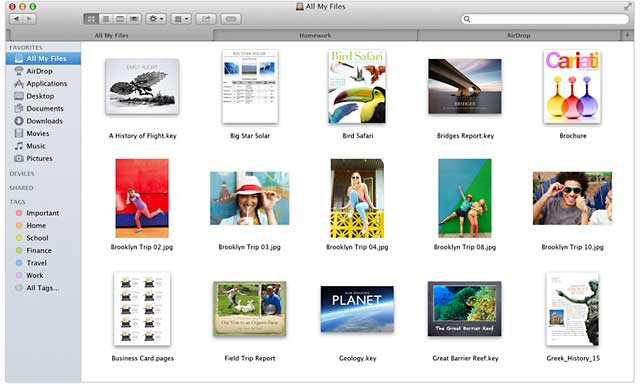
This one has been a long time coming. The first tabbed browsers appeared in the late 1990s, my favorite Mail add-on (MailTabs) gives it a tabbed interface, and with OS X Mavericks, the Mac’s Finder will finally have it as well.
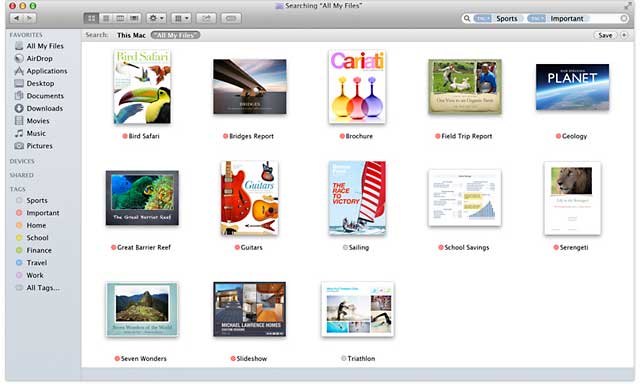
OS X Mavericks gets document tags.
The Finder will also include a fullscreen mode and add document tags, which should be a lot more useful than the Label feature that has let you assign one of eight colors to apps, documents, and folders as far back as System 6.
Apps and Services
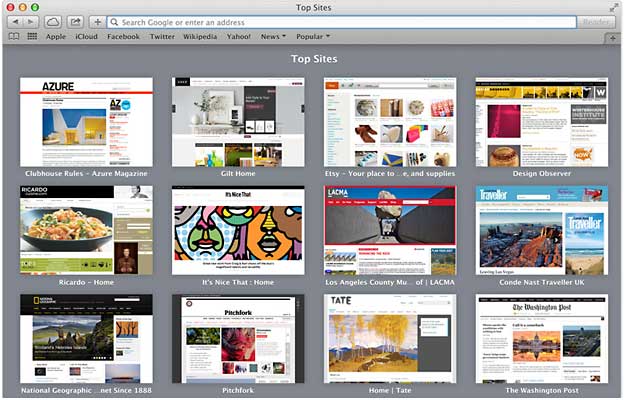
Over the past 15 years, the Web browser has become the most important application on any platform, and Safari gets some improvements with Mavericks. The Top Sites feature has been redesigned, and a new sidebar feature has been added, which can contain your bookmarks or links shared by others using Twitter and/or Linkedin, and Linkedin sharing has been added as well.
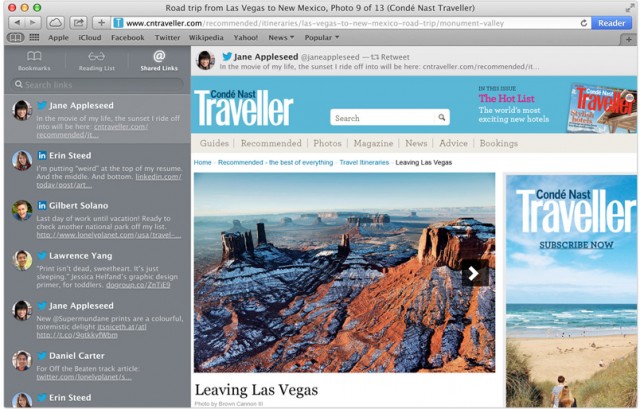
Shared links in Safari’s new sidebar.
The new version of Safari also has Nitro Tiered JIT, Fast Start, and power-saving technologies to speed up the Web and make your MacBook last longer in the field.
The OS X Keychain, now known as iCloud Keychain, lets you sync IDs and passwords between your OS X 10.9 and iOS 7 devices. Everything is protected with 256-bit AES encryption, and the operating system will keep things in sync as you make changes.
Notification Center is being significantly updated for Mavericks, making it easier to respond to messages, FaceTime calls, and email. It can also display breaking news, sports scores, auction alerts, and more.
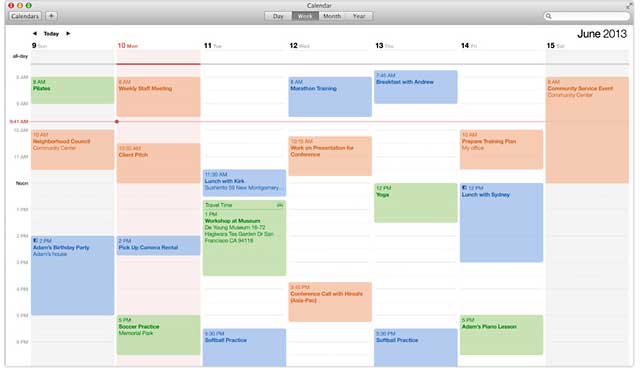
Calendar has a fresh new look and adds continuous scrolling, so in month view you can see a range of weeks that doesn’t have to match up to a calendar month. Nice! The Inspector has been updated as well.
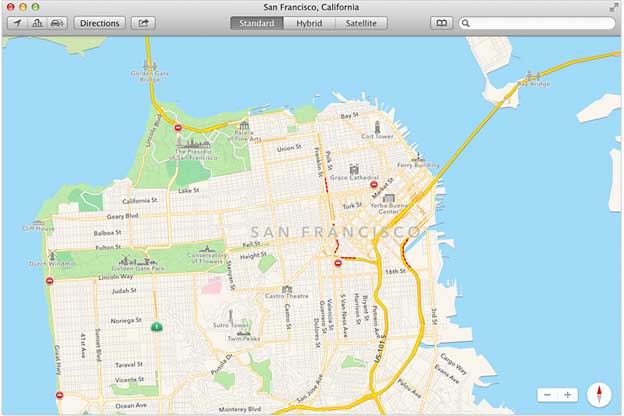
New apps include iBooks, which syncs with your iOS devices, and Maps. And with maps, you can sync your route between your Mac and your iPhone and have voice navigation along the way.
Networking
Mavericks introduced networking via Thunderbolt, much as earlier Macs supported networking via FireWire. This appears as Thunderbolt Bridge in the Network system preference. On Macs with more than one Thunderbolt port, only one port can be used for the bridge – trial and error is necessary to figure out which port is supported. This can be significantly faster than Gigabit ethernet, which remains the fastest version of ethernet supported by Macs. (Gigabit ethernet first came to the Mac with the Sawtooth Power Mac G4 in August 2000.)
Lost Features
- Open Transport: Apple introduced Open Transport networking with System 7.5.2 and the Power Mac 9500 in May 1995, made it the Mac’s default networking system with Mac OS 7.6 in January 1997, officially deprecated it with the released of OS X 10.4 Tiger, and completely eliminated Open Transport from the Mac OS with the release of Mavericks.
Conclusion
Where OS X 10.7 Lion introduced a new user interface, one derived from iOS, and 10.8 Mountain Lion added the polish and finesse Lion didn’t quite have, 10.9 Mavericks takes OS X to a whole new level. Time Coalescing, App Nap, and on-the-fly memory compression will give it significantly improved performance and responsiveness, perhaps finally catching up to what the Classic Mac OS achieved with Mac OS 9.
Best of all, every Mac capable of running OS X 10.8 Mountain Lion will be compatible with Mavericks, and with a projected $19.99 price tag, there should be no reason for Lion and Mountain Lion users not to make the move.
Keywords: #osxmavericks, #macosxmavericks
Short link: http://goo.gl/RrOF7g
searchword: osxmavericks


You mention above that “my favorite Mail add-on (MailTabs) gives it a tabbed interface” …I have been dying to use MailTabs but it hasn’t been supported since Snow Leopard. Do you know something I don’t know? Can I get MailTabs working on Mavericks????
I’m still using Snow Leopard. Just installed Mavericks and will investigate.
Mailtabs is still MIA. So is my other favorite Mac mail plugin, TruePreview. :(